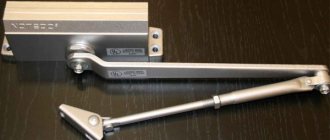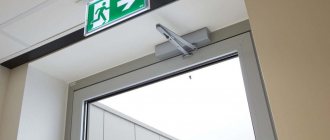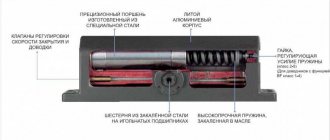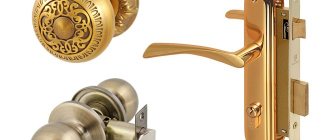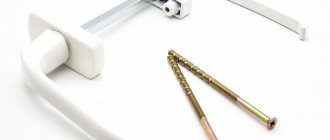0
7789
03.04.2014
Door closers are designed for automatic, smooth closing of doors. The use of a closer is a prerequisite when installing an intercom and a combination lock; in addition, closers are used in public institutions, on entrance doors and gates, and in private households.
How to install a door closer
Device and principle of operation
Most modern devices of this type are based on a spring, which is compressed when the door is opened. When the pressure on the door stops, the spring relaxes, returning it to the closed state.
Door closers can be of different types, types and colors
The main difference between different types of closers is the method of transmitting force to the spring: there are devices with a hinged rod or with a sliding channel. But in general, the principle of operation is this.
By opening the doors, we activate a gear that transmits force to a rack (hidden in a metal cylinder) filled with oil. The rack drives a piston, which pushes the spring, compressing it. When the piston moves, oil flows from one part of the chamber to another, providing a certain resistance and slowing down the movement of the door leaf.
The internal structure of a door closer for an entrance or interior door
As soon as the pressure stops, the spring begins to expand, pushing the piston in the opposite direction. At the same time, the oil again flows from one part of the device to another, slowing down the slamming.
As you can see, the speed of movement of the door and the force required to open it depend on several factors: the power of the spring, the ease of movement of the gear, rack and piston. The degree of viscosity of the oil also has a great influence: at low temperatures it becomes more viscous and flows worse; at high temperatures, fluidity, on the contrary, increases, doors close faster. Therefore, the door closers on the entrance doors have to be adjusted with each change of season.
In addition to devices that use gears to transmit torque, there are mechanisms with cam elements. The cams have an uneven, heart-shaped shape; turning it also changes the force required to open the door and the speed of its return to the closed state. This makes it possible to make smoother adjustments. However, the most common mechanisms on the market are those with gears: they are more reliable.
Concealed mounting devices: types of mechanisms
When there is a stylistic requirement for a room's design solution, in addition to aesthetic floor mechanisms that work to close, hidden systems are often used to cover the canvases. With the use of typical devices, the presence of such a mechanism, as such, is completely hidden. The door closer for a hidden-mounted door can be divided into two types:
- Hidden door closers with a sliding rod, in essence, are virtually indistinguishable from analogues of the top installation method. Moreover, the mechanisms are endowed with a simple but miniature design, which makes it possible to hide themselves in the door frame of the opening or in the array of the ceiling sheet itself.
- A door closer in the form of a hinge is the most miniature creation of a door closing system. The entire structure of a typical mechanism is hidden in the door hinge body. Hinges-closers are quite a promising device, since this closer can be installed on the door without any additional steps regarding chiseling/drilling of the panels. Of course, this applies exclusively to the entrance structure of the opening that requires hinges.
Due to their specific nature, closer loops are endowed with some disadvantages:
- Their scope of use is somewhat limited;
- It is not recommended to install the devices on heavy door leaves;
- The miniature nature of the mechanism is endowed with a small operational resource;
- Hidden type door closers (hinges) are quite demanding on the process of installing the door leaf.
Features of choice
When choosing a door closer, pay attention to several points. These are the dimensions of the door, its location (external or internal), as well as the angle at which it should open and a possible method of installation.
Classification by mechanism power
The closer is selected based on the force that the mechanism develops when closing the door. The required power of the mechanism is affected by the weight of the door leaf and its width. These two characteristics are the main ones when choosing a power class.
If we talk about standardization, the domestic GOST R is currently in force. But its requirements are much lower than the world standard EN 1154. Products supplied to the market from European and other manufacturers are certified according to the world standard, products from domestic manufacturers are certified according to GOST.
According to EN 1154, closing forces are divided into seven categories: from EN1 to EN7 (1 is the least significant for light and narrow doors, 7 for the most massive). There are models of only one class E4 or E2. The force adjustment in such devices is within very small limits. But their price is small.
Table for selecting the class of door close depending on the weight and width of the door leaf
There are more expensive door closers that have a wide range of adjustments. Then in catalogs their class is indicated with a hyphen: EN2-5, for example. They are more convenient because, depending on weather conditions, you can adjust the required closing speed.
External or internal door
Despite the fact that closers can be installed on any side of the door, on external doors it is better to install them indoors: atmospheric phenomena will have less impact. But even in this case, a frost-resistant model is necessary.
When installing in the entrances of apartment buildings, it is desirable to install models that are not so easy to break: protruding rods irritate many. Therefore, a model with parallel or sliding traction is needed.
Types of installation of a lever closer
Where to put
Most often, closers are installed on external and entrance doors, as well as on gates and entrance gates. They can be found in apartments and country houses, in office buildings and commercial facilities.
In some door models, the door closer is included in the basic package. The closer must be installed on fire and evacuation doors, entrance areas with an intense flow of visitors, and in access control systems.
On doors, the housing must be indoors. The external location causes corrosion and negatively affects the operation of the hydraulics. Only frost-resistant models, protected from external factors, can be used outdoors.
Installation methods
Based on the installation principle, door closers are divided into four types:
- Outdoor installation. Such models consist of two blocks, one of which is attached to the door leaf, the other to the lintel of the door frame. They are connected using movably articulated levers. Installation methods for such models are shown in the figure.
- Hidden installation in frame. A hole is cut out in the lintel of the door frame and a door closer is installed into it. A lever is attached to the top of the door leaf.
- Hidden installation in the floor. This type can often be seen on glass swing doors in stores. Installation with a door leaf made of any material is possible, but only at the stage of installation or general reconstruction: it is necessary to make a recess in the floor under the body of the closer.
- Hidden installation in the door. In this case, a recess is made in the upper end of the door into which the device is installed, and the lever is attached to the door jamb.
Installation methods may be different.
Any of the installation options can be done with your own hands. It just requires varying degrees of skill. The simplest is external installation. It has the widest distribution.
Connect the lever to the rod
When the rod and lever are fixed, it is important to give the desired position, which will determine the speed of movement of the door before closing. The position and length of the two-piece rod can be adjusted with a long grub screw. It rotates and changes size at the same time.
Installing the rod perpendicular to the door leaf will help to achieve smooth finishing. To do this, make a setting and reduce its size. If there is a door latch, the pull must be strengthened to overcome the resistance. The mechanism is untwisted and adjusted to make it longer.
DIY installation
Modern manufacturers of high-quality (and therefore expensive) mechanical door closers even include templates for installation in the instructions for the device. Typically these are adjustable models with different force classes for closing doors.
If such a template exists, choose the class required for your case (based on the weight and width of the door leaf). Decide where the device body will be attached: to the door leaf or to the jamb. It depends on which way the doors open.
If you have a template, installing the door closer yourself is not difficult at all.
In our case, we install the body on the door leaf. Therefore, we apply and secure (with tape) the corresponding template, and drill holes directly through it.
The next step is installing the closer body. If there are drilled holes, this is a matter of one minute.
Now you need to correctly install the lever “foot” on the door. The force class depends on how it is installed (see the diagram), we need 3-4, so we choose the lower option.
The class of the device depends on the method of installing the presser foot
The lever itself consists of two halves. One of them is solid, the second is composite. The composite one also has two halves, twisted using a threaded connection. Using this thread, the length of this lever arm is adjusted. The solid shoulder is attached to the body, the composite one - to the foot (they are not yet connected to each other).
Depending on whether the door has a latch or not, one or the other arm of the lever is set perpendicular to the door
Now you need to choose which shoulder will be perpendicular to the door leaf. A solid shoulder is placed at an angle of 90o to the door if the door has a latch. If there is no latch, the assembly arm is set at a right angle. Their position is adjusted by the length of the threaded lever - you lengthen or shorten it. Having exposed the lever, its halves snap into place: bring the ends together and press them against each other until they click. In any case, this is exactly what happens in this model. In others, the connection may be different, but the installation principle is similar.
Installing a door closer: instructions with photos
To install the closer on the door, you only need a drill, a ruler, a pencil and a screwdriver. A drill is usually required “3” (three), but you need to look at the diameter of the fastener, which usually comes with the kit.
What is needed to install a door closer
Most manufacturers, to facilitate self-installation of the closer on the door, complete the products with installation templates. These templates schematically depict the parts of the closer in full size. They also have mounting holes for each element. In models that can create opening forces of different classes, the holes are drawn in different colors; in addition, they are labeled - the class of the closer is placed next to it.
Example template for installing a door closer
The template is printed on both sides of the sheet. On one side - for opening the doors "towards you" - from the side of the hinges (pictured above), on the other - "from you".
Installing a template
The template has two perpendicular red stripes. We align the horizontal one with the top edge of the door leaf, the vertical one with the axis line of the hinges.
Installing a template
Everything is clear with the upper edge of the door leaf, but to avoid mistakes during installation, you need to draw the axis line of the hinges. If the door closer is installed from the hinge side, there are no problems - use a long ruler and pencil to move the line of the middle of the hinges upward. If installation will be carried out on the other side, measure the distance from the edge of the canvas to the middle of the loop. Mark this distance on the other side and draw a line.
Holes for door closer
On the template we find marks for holes according to the selected class. Using a drill or awl, we transfer them to the door leaf and frame.
Transfer the marks for the holes to the canvas and frame
Typically, the kit includes two types of fasteners: for metal (metal-plastic) and wood. We select a drill of a suitable size and use a drill to drill holes in the designated places.
Door closers are equipped with two types of fasteners - for metal and wooden doors
Drill holes according to the marks
Next, the actual installation of the door closer begins. Please note that for installation it is necessary that the housing and arms are disconnected. If they are assembled, they are separated (the washer is unscrewed, the screw connecting the levers and the body is removed).
Installation
We attach the parts to the holes made and install the fasteners. In the diagram we find the class of opening force that we need (in this case EN2) and install the parts as shown in the figure.
Door closer installation diagram
To open “towards you,” we place the body on the door leaf and install a rod on the frame.
Installing the case
We fasten the rod
Now you need to connect the traction lever to the body. There is a special protrusion at the bottom of the case. We put a lever on it and tighten it with a screw.
Installing the traction lever
Now all that remains is to connect the lever to the rod. There are two options.
Self-installation of the front door is described here.
Connect the lever to the rod
The connection of the lever with the rod itself is very simple: the two parts are combined and slightly pressed with your fingers. They lock into place with a slight click. The trick is how to position them relative to the door. The rate of movement of the door leaf at the final stage of closing depends on this. The position can change due to the fact that the rod consists of two parts and can be adjusted in length - one of the parts of the rod is a long threaded pin. Rotate the pin to shorten or lengthen it.
If you just need a smooth finishing, the rod is placed so that it is perpendicular to the door leaf. To do this, reduce its size slightly (pictured on the left).
Lever and rod placement for setting finishing force
If the door has a latch, a significant force is required to overcome its resistance. For this option, a shoulder is placed perpendicular to the door (the rod is untwisted, making it longer).
Having arranged the parts accordingly, they are combined and connected. That's all, the installation of the door closer is complete. And you can handle it with your own hands, and without much difficulty. The final stage remains - setting the closing speed. To do this, you need to understand the adjustments of door closers.
How to put on a gate
Frost-resistant models that can be used outside are suitable for installation on a gate. But not all gates have a top crossbar. But everyone has side racks. In this case, the rod is attached to the side post by unfolding the mounting plate along the post.
Installing a door closer on a gate without a top crossbar
But hydraulic devices (discussed in this article) do not do well in the cold. The oil that is poured into the body and serves to “brake” the door leaf becomes more viscous, and the gate closes more slowly. From this point of view, it is better to choose a pneumatic model for the gate (read about selection and installation here).
How to install on a metal door
Installation of a closer on metal doors differs only in the type of fasteners used and the size of the drill. Since the canvas is usually heavier, powerful models of at least class 5 are selected (check the table). Accordingly, on the installation template you will need markings for another class.
The door closer is installed on a metal entrance door in the same way.
You may also need a more powerful drill, but these are all details. Otherwise, you need to install a closer on metal doors in the same way as wooden or metal-plastic ones.
Adjustment and maintenance of the closer
It is impossible to talk about adjustment “in general”: different manufacturers install screws in different places. Somewhere they are located on the side surface, somewhere under the removable panel on the front part, at the bottom or top of the case. Simple models have only two adjustment points, while more complex ones can have five or more. Therefore, each model has its own instructions.
In general terms, we can only talk about periodicity. As the temperature decreases or increases, the viscosity of the oil changes. And its condition changes the speed of door slamming. Doors that close too quickly cause inconvenience: they push the person passing behind. Older people will definitely not like this. Slowly closing doors make you want to help them and push them. But for the mechanism, this help is death: several dozen assistants and you will have to buy another mechanism. Therefore, timely seasonal adjustment of door closers prolongs their life.
We need to talk about adjusting the closers only in relation to each model: they are too different in design
Maintenance of the closer consists of changing the oil in the housing. This must be done once a year. The procedure is described in detail in the instructions and differs for different models, just like the adjustment.
Manufacturers and reviews
The ranking of door closer manufacturers is as follows: the German companies Dorma and Boda deservedly occupy the first and second places. Enterprises specialize in the production of models with sliding traction, which are very popular and are much better bought than knee models. Following the German companies are the Italian Cisa and Cobra, offering consumers traditional lever and hidden floor devices. Next comes the Korean KDC, which uses German components and produces anti-corrosion models for outdoor installation, and the Finnish Abloy closes the top six.
Products from this company are equipped with independent valves that ensure smooth operation and ensure tight closure. In addition, models from Finland are equipped with a very precise control system, which responds very responsively to the slightest change in settings. Buyers consider the only drawback of foreign models to be quite high cost. Thus, the price of especially powerful models designed to control heavy steel doors can reach 38 thousand rubles.
Russian-made models are also popular and in demand on the domestic market. Devices from well-known and Nikiret are in no way inferior to imported analogues in terms of their performance characteristics, have many positive reviews and are sold well not only in Russia, but also in neighboring countries. Consumers note the high adaptability of the devices to Siberian frosts and the ability to use the devices in almost all regions of the country. In addition, Russian door closers are much cheaper than their European counterparts, which makes them even more popular and in demand.
Additional functions
In cheap products, looking for additional functions is a waste of time. More expensive models may provide a number of additional amenities.
Fixing the open position (hold-open)
From time to time there is a need to leave the doors wide open. For example, in order to bring in or take out a large item. Holding conventional door closers for a long time spoils the mechanism. In order not to damage the device, there are special models with the function of fixing the open position. They are equipped with a mechanical or electromagnetic latch. The operation of a mechanical latch is simple: when the door is opened at an angle exceeding 90o, the latch is activated. It is easy to remove: you need to pull the canvas towards the closing side. In models with electromagnetic latches, the doors are held as long as there is current in the network. Once the chain is broken, the doors are unlocked (there is a special unlock button).
Opening delay (damper)
This is a feature that prevents the door from opening very quickly. This eliminates the possibility of injury to the person on the other side of the door.
Closing delay
It is necessary in those rooms through the doors of which some kind of cargo is carried out. However, the flow of people should not be large.
Scope of use of specialized door closers
A specialized door closer is a device designed for sliding door panels. The list of sliding panels also includes doors for sliding wardrobes. Regarding its essence, a device for sliding systems is the same furniture mechanism used to prevent the impact of furniture doors. The difference between the designs used for sliding systems lies in the initial force created. Installation of specialized devices for sliding structures is carried out by cutting them into the leaf itself or into the door frame, which serves as a stop for the sliding blocks. A door closer of this type for sliding structures is installed quite simply:
- Holes of the required diameter are made in the end part of the door leaf or in the frame of the sliding blocks;
- Next, door closers intended for sliding structures are inserted into holes with the appropriate diameter.
The door closer of a specialized type has the only drawback, which is the protruding pins. It is permissible to cling to the pins with something, of course not to fall, but to break the door closer.
Spring closers
Door closers are not only mechanical. There are also spring ones. They are considered outdated, but you must agree that you can install an automatic closer in a house or apartment only on the entrance doors. And then, the question of feasibility remains open.
Spring closers - an option for interior doors
At the same time, in some rooms it is advisable to keep the doors closed. Then it makes sense to install spring closers. They cost several times less and are easy to install. Their disadvantage: they are not adjustable and press with constant force. However, a good option for a bathroom door, for example. You can see how one of the spring door closers works in the video.
Everything about the installation is simple. They are installed on the side where the door hinges are installed. Screw the device to the jamb at a convenient height for you. All. Installation is complete.
Some models have a guide that is mounted on the door leaf. A roller attached to an outrigger rod runs along it. This device is more progressive: it does not damage the doors. But during installation, you need to check the level to install the guide.
There are spring closers in some door hinges. Of course, they are installed during the installation process, but it doesn’t hurt to know that there is such a miracle: hinges with a closer.
Where is it wise to install a door closer and where is it not worth it?
Most often, devices are installed on those doors for which it is important to be constantly closed: street and entrance doors. When installing the housing, they try to place it not outside, but inside the house or apartment
Frost-resistant models exist, but they are much more expensive, require more frequent maintenance and still have temperature restrictions. It is not recommended to install door closers on lightweight interior panels, especially those with glazing or stained glass. Frequent activation of a spring that is too strong can lead to loosening, rattling and even glass falling out
When installing, they try to place the housing not outside, but inside the house or apartment. Frost-resistant models exist, but they are much more expensive, require more frequent maintenance and still have temperature restrictions. It is not recommended to install door closers on lightweight interior panels, especially those with glazing or stained glass. Frequent activation of a spring that is too strong can lead to loosening, rattling and even glass falling out.
The door to the sauna also requires external installation of a door closer or a recessed structure. A conventional device will quickly fail due to changes in temperature and humidity.
Adjustment
After the closer is installed, it must be adjusted. The adjustment method depends on the location of the adjusting screws, which can be located either at the end of the housing or inside it. Typically, screws are designated by numbers 1 and 2, where “one” is responsible for changing the angle of the door opening relative to the frame, which can reach 180 degrees, and “two” is responsible for the speed at which the door will close. The opening angle is adjusted first. To do this, set the desired value, which can vary from 90 to 180 degrees, after which they proceed to regulate the speed of the web.
It is produced in this way: the door is opened to the maximum possible angle that was just set, and released. At this time, they begin to tighten the second screw, achieving smooth operation and stable closing. Typically, the mechanism reacts very sensitively to changes in the position of the adjusting screws, after turning it just a quarter, the blade begins to close extremely slowly. Some closers have a door locking function, so when adjusting such models, you will need to adjust the locking trigger point when the door is open.
Operation and care
The automatic closer does not limit the opening of the sash. To prevent the mechanism from breaking, install a stop that prevents the door from swinging open too much. For models with a slider lever, the limiter is mounted in the guide channel.
Blocking the door open with various supports or manual force to quickly close the door wears out the mechanism, and sometimes even breaks parts. When installed outdoors, the closer body is protected with a visor from precipitation and sun. To extend service life, all moving parts are lubricated.
If the doors have no defects and the conditions of use are met, the closer will serve the time guaranteed by the manufacturer.
Tips for use
Even if the closers are installed according to all the rules, sometimes you have to interfere with their operation. But in order for such a need to arise less often, you need to follow basic rules. The device must close the door on its own - this is its main purpose. If the closing speed is too high or too low, there is no need to help or hinder the blade. In such cases, the mechanism is adjusted.
Do not abuse the ability of doors to remain open. Moreover, you should not place various unnecessary objects under the canvas. You should also not hang on the door or use it for riding. Children love this kind of entertainment - and they need to be carefully monitored. If you notice that the device is not working properly, you need to look to see if any oil drips have appeared.
At the same time, adjustment of the internal part of the mechanism should still be entrusted to professionals
There is a powerful spring, which requires care when handling. But it is quite possible to adjust the operating speed - to do this you need to tighten or loosen special screws
Caution: they cannot be completely removed, as this may cause depressurization of the closer. Before performing this work, you need to check the technical documentation again, then the risk will be minimal.
